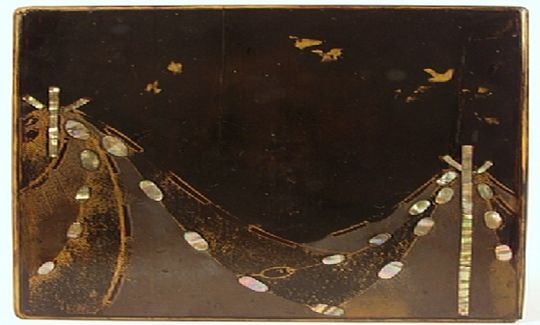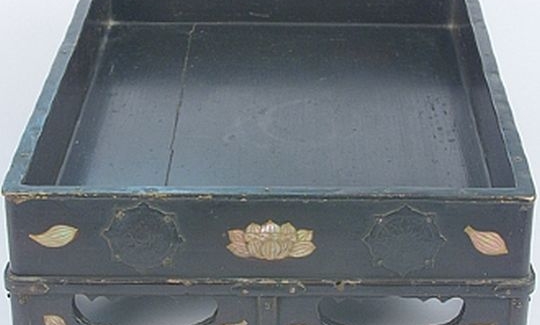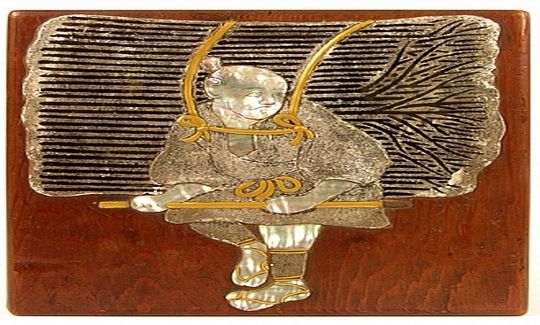A Japanese fable relates that, while out hunting, Prince Yamato Takeru was enchanted by the beauty of the trees in their autumn glory. Takeru broke off a branch in order to examine its splendid foliage more closely. At the spot where the branch had been broken away, resin began to ooze out, which rapidly congealed into a shining black liquid. Takeru decided to decorate one of his most precious possessions with this solution, and thus the Japanese began decorating with lacquer. Lacquer work is used to embellish practical objects - household wares and furniture - as well as decorative articles.
Lacquer ware is made in many regions of eastern Asia. In China and Japan, the art of lacquer was already known in the 2nd millenium BCE. Archaeological finds indicate that decorated lacquer ware existed in Japan in the Jomon era (10,000 - 300 BCE), and it is mentioned in Japanese literature in 587 CE.
Lacquer is made from the resin of the rhus tree (Rhus vernicifera), which is spread in many layers (nuri) over the various articles until they are completely covered. The raw sap (ki urushi) was used to seal or reinforce containers, especially those which held food. Lacquer darkens in contact with oxygen, and dries and hardens particularly well in the humid climate of Japan. The raw lacquer is processed until it becomes shiny black or red, and then spread on the surface of the dish. There are several methods and specific processes for creating lacquer, which is sometimes used in its original state, and sometimes made to look like metal. The latter process is particularly evident in the maki-e technique - designs created by sprinkling gold or silver dust on the surface, and in kamakura-bori - carving the lacquer or the wood. Lacquer decoration varies from smooth surfaces emphasizing the form of the dish to designs which deliberately depart from it, reminiscent of ceramic wares. There is usually no connection between decoration and function, but these decorations have been conducive to great technical and artistic virtuosity.
The basic objects to be covered with lacquer are made of various materials, including wood, bamboo, leather, ceramic, wicker, and even articles of clothing. In most periods the hard wood of the Japanese cypress or the paulownia tree was used. The outer surface was frequently covered with paper, silk, or hemp before the lacquer was applied, to ensure an absolutely smooth surface. In the 17th century, another technique was to cover the layer with a substance derived from seaweed (funori: agar-agar). When this comes into contact with water, it forms a solid, transparent film. Later, to make the process less costly, newspaper was used, or the surface was left uncovered before the lacquer was applied.
There is a long tradition of lacquer in Japan, handed down from father to son. Creating a perfect item of lacquer demands much experience. Firstly, so that a container can be easily opened or closed and yet be sealed hermetically, the artist carving the outside must take into account the many layers of lacquer (thirty or more) which will then be applied by the lacquer artist. Drying and polishing the lacquer after application of each layer are also lengthy procedures. Some artists specialize in gold lacquer, while others specialize only in decoration.
As with other Japanese crafts, lacquer work was under government control. In 701 a command was issued to plant rhus vernicifera groves, and a tax was imposed on sales of lacquer ware. At that time Japan began to develop an industry for practical lacquer wares. They also started to use lacquer to decorate the samurais' equipment, especially the scabbards of their swords. While excavating a royal palace of the Nara era (Nara: 710-794), headgear embellished with lacquer, which had belonged to the aristocracy were also found. Because lacquer solidifies so easily, it was possible to create lacquer headgear which would retain the desired shape. At this time Buddhist statues were also made by the dry lacquer technique (kanshitsu), which reached Japan from China, where it was already known in the Han era (206 BCE - 220 CE). In China, this technique was known as "cloth in layers" (chia chu). Cloth was dipped in lacquer solution and then placed, layer upon layer, over a frame, which was removed after the lacquer had hardened into the required shape. The advantage of these statues, which were sometimes covered with gold leaf, was their lightness, so that they could easily be moved from place to place.
Until the Nara period, only the black and red lacquer which had been used to seal coffins in ancient times were known in Japan. Red lacquer is considered to be endowed with supernatural power, perhaps because red is the colour of life. In the Nara era, the Japanese lacquer artists began to employ other colours, in particular yellow and green, but lacquer ware with five colours can also be found. To create these different shades, pigments were added to the lacquer: a mixture of acetate (containing salts of lemon), iron, soot, and an intensely black pigment used for colouring women's teeth (ohaguro). Cinnabar was used for red; and from a compound of orpiment (arsenic trisulphide) and indigo they made green.
By the beginning of the 8th century, the Japanese craftsmen knew how to use coloured lacquer, but apparently preferred the black, and lacquer work attained the highest standards of artistry. They began to use different styles of ornamentation. A brush was used to paint directly on the lacquer with a solution of gold and silver powder mixed with various glues (kingin-e). The disadvantage of this technique is that, with time, the painted layer tends to flake away. Another technique was to add scraps of gold leaf and silver to the lacquer, to create a smooth surface (heidatsu, or hyomon). Inlay (raden) of different materials was also used, especially mother-of-pearl, which came from China, and ivory. This technique became very popular in the Edo era (Edo: 1603-1868) and was adopted by the Samada family of lacquer craftsmen. The Samada developed this technique to the level of mosaic work, and thus lacquer inlaid with mother-of-pearl is known as "Samada lacquer". In the second half of the 19th century, the Shibayama family specialized in carving ivory inlays for the lacquer, and Shibayama became the term for this technique, which is still employed for ivory and other materials.
From the 8th to the 10th centuries they decorated the lacquer by spreading powdered gold and silver on the surface and polishing it (makkinru). As of the Heian era (Heian: 794-1185) this technique became known as maki-e, of which there are many variations, the most important being: hiramaki-e, in which the smooth surface is preserved; takamaki-e, developed in the Kamakura era (1185-1392), in which the gilded ornamentation is applied in relief, using charcoal or powder as a base, so that it is not merely visible, but also tangible. Togidashi is yet another technique in which layers of lacquer are applied over maki-e, after which the surface is ground and polished until the picture is revealed. In the nashiji technique, fine gold dust is spread on the lacquer surface. The word ‘nashiji' suggests the golden peel of the Japanese pear (nashi). In Europe, this technique is known as aventurine, after a type of Venetian glass which it resembles. The difference between maki-e and nashiji is that in the latter the entire surface is sprinkled with powdered gold, whereas in maki-e the powder is only applied to the decoration.
Kamakura-bori is yet another technique which appeared in the Kamakura era, and originated in China. Originally, carving was done through the many layers of lacquer, but articles of carved wood were also made, and the carving was then covered with lacquer. At the beginning of the Muromachi era (Muromachi: 1336-1573), this technique was very popular because the monks carried boxes of this type containing the holy scriptures. Favourite motifs were camelia and peony flowers.
The decoration of lacquer objects was delicate and elegant, its motifs taken from nature, daily life, fables, religion, poetry and literature. For example, the motif "gosho guruma" - a cart with moonflowers - is taken from an episode in "The Tale of Genji" (11th century), Prince Genji's visit to the home of the Princess Moonflower. Decorations also incorporate calligraphy and pictograms (ashide), including verses of poetry or Chinese symbols. In the Edo era, the motifs were taken from the coloured woodblock prints, particularly those of famous views.
Among the exhibits are writing-boxes (suzuri-bako) and incense-boxes (kogo), mainly from the Edo period, the last and most brilliant era of traditional Japanese art. At that time a ‘middle class' existed, which was thirsty for impressive objets d'art. The desire to acquire valuable and beautiful objects is, to some extent, responsible for the special styles and techniques to be found in this exhibition.




